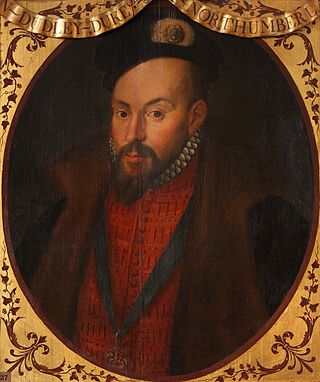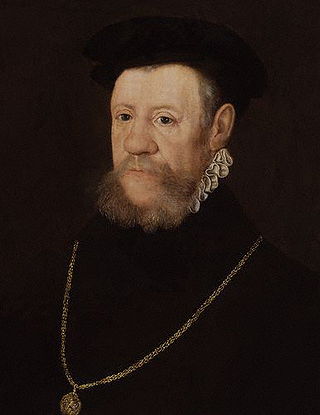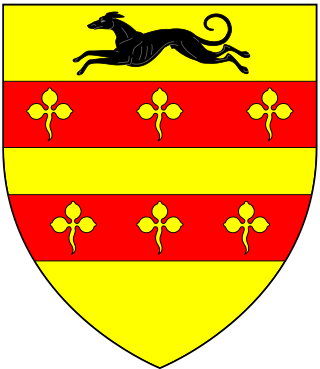Related Research Articles

John Dudley, 1st Duke of Northumberland was an English general, admiral, and politician, who led the government of the young King Edward VI from 1550 until 1553, and unsuccessfully tried to install Lady Jane Grey on the English throne after the King's death. The son of Edmund Dudley, a minister of Henry VII executed by Henry VIII, John Dudley became the ward of Sir Edward Guildford at the age of seven. Dudley grew up in Guildford's household together with his future wife, Guildford's daughter Jane, with whom he was to have 13 children. Dudley served as Vice-Admiral and Lord Admiral from 1537 until 1547, during which time he set novel standards of navy organisation and was an innovative commander at sea. He also developed a strong interest in overseas exploration. Dudley took part in the 1544 campaigns in Scotland and France and was one of Henry VIII's intimates in the last years of the reign. He was also a leader of the religious reform party at court.

Sir John Cheke was an English classical scholar and statesman. One of the foremost teachers of his age, and the first Regius Professor of Greek at the University of Cambridge, he played a great part in the revival of Greek learning in England. He was tutor to Prince Edward, the future King Edward VI, and also sometimes to Princess Elizabeth. Of strongly Reformist sympathy in religious affairs, his public career as provost of King's College, Cambridge, Member of Parliament and briefly as Secretary of State during King Edward's reign was brought to a close by the accession of Queen Mary in 1553. He went into voluntary exile abroad, at first under royal licence. He was captured and imprisoned in 1556, and recanted his faith to avoid death by burning. He died not long afterward, reportedly regretting his decision.

Henry Fitzalan, 12th Earl of ArundelKG was an English nobleman, who over his long life assumed a prominent place at the court of all the later Tudor sovereigns.

Henry Grey, Duke of Suffolk, 3rd Marquess of Dorset, was an English courtier and nobleman of the Tudor period. He was the father of Lady Jane Grey, known as "the Nine Days' Queen".

William Paulet, 1st Marquess of Winchester, styled Lord St John between 1539 and 1550 and Earl of Wiltshire between 1550 and 1551, was an English Lord High Treasurer, Lord Keeper of the Great Seal, and statesman.

Sir Thomas Chaloner was an English statesman and poet.

Edward Fiennes, or Clinton, 1st Earl of Lincoln KG was an English landowner, peer, and Lord High Admiral. He rendered valuable service to four of the Tudor monarchs.

William Parr, Marquess of Northampton, Earl of Essex, 1st Baron Parr, 1st Baron Hart, was the only brother of Queen Catherine Parr, the sixth and final wife of King Henry VIII. He was a "sincere, plain, direct man, not crafty nor involved", whose "delight was music and poetry and his exercise war" who co-authored a treatise on hare coursing. He was in favour with Henry VIII and his son Edward VI, under whom he was the leader of the Protestant party, but having supported the desire of the latter to be succeeded by the Protestant Lady Jane Grey, was attainted by Edward's Catholic half-sister, Queen Mary I. He was restored by her Protestant half-sister, Queen Elizabeth I. He married thrice but died without issue.

William Herbert, 1st Earl of Pembroke, 1st Baron Herbert of CardiffKG PC was a Welsh Tudor period nobleman, politician, and courtier.

Thomas Wentworth, 2nd Baron Wentworth was an English peer, courtier, administrator and military commander during the reigns of Edward VI, Mary I and Elizabeth I. His reputation suffered through the surrender of Calais in 1558, which occurred under his command.
Events from the 1550s in England. This decade marks the beginning of the Elizabethan era.

Sir Thomas Gargrave (1495–1579) was an English Knight who served as High Sheriff of Yorkshire in 1565 and 1569. His principal residence was at Nostell Priory, one of many grants of land that Gargrave secured during his lifetime. He was Speaker of the House of Commons and vice president of the Council of the North.

Sir William Sharington was an English landowner and merchant, a courtier of the time of Henry VIII, master and embezzler of the Bristol Mint, member of parliament, conspirator, and High Sheriff of Wiltshire.

Sir Thomas Palmer was an English soldier and courtier. His testimony was crucial in the final downfall of Edward Seymour, 1st Duke of Somerset in 1551–1552. Palmer was executed for his support of Lady Jane Grey in the succession crisis of 1553.

Sir Andrew Dudley, KG was an English soldier, courtier, and diplomat. A younger brother of John Dudley, 1st Duke of Northumberland, he served in Henry VIII's navy and obtained court offices under Edward VI. In 1547–1548 he acted as admiral of the fleet and participated in the War of the Rough Wooing in Scotland, where he commanded the English garrison of Broughty Castle. He was appointed captain of the fortress of Guînes in the Pale of Calais in late 1551. There he got involved in a dispute with the Lord Deputy of Calais, which ended only when both men were replaced in October 1552.
Sir Henry Gates, of Seamer, Yorkshire; Kilburn, Middlesex; Kew, Surrey and Havering, Essex, was an English courtier and politician.
Sir Leonard Chamberlain or Chamberlayne was an English soldier and politician. He was the Governor of Guernsey in 1553.
Peter Yorke, of Gouthwaite, Yorkshire, was an English landowner and politician.
Stephen Proctor or Procter was an English courtier, a minerals and financial speculator, and Yorkshire landowner who built Fountains Hall.
John Yorke or Yorke (c.1566–1634) was an English landowner and mining entrepreneur.
References
- 1 2 3 4 Anne Ashley Cooper (1988). Yorke Country. A. Ashley Cooper. ISBN 0-9511112-21.
- 1 2 "York, Sir John". Oxford Dictionary of National Biography (online ed.). Oxford University Press. doi:10.1093/ref:odnb/30233.(Subscription or UK public library membership required.)
- ↑ Charles Bremont, 'Les Révolutions D'Angleterre en 1553 et 1554 racontées par un fourrier de L'Empereur Charles-Quint', Revue Historique, 110:1 (1912), p. 66.
- ↑ "History of Parliament". History of Parliament Trust. Retrieved 8 November 2011.
- 1 2 Jennings, Bernard (1992). A History of Nidderdale. p. 119. ISBN 1-85072-114-9.
- ↑ William Page, ed. (1923). "The liberty of Whitby Strand". Victoria County History. A History of the County of York North Riding: Volume 2. pp. 502–505. Retrieved 25 April 2019.
- . Dictionary of National Biography . London: Smith, Elder & Co. 1885–1900.
- Craig, John (1953). The Mint: A History of the London Mint from A.D. 287 to 1948. Cambridge, England: Cambridge University Press. pp. 113–115. ASIN B0000CIHG7.
- Attribution
![]() This article incorporates text from a publication now in the public domain : "York, John". Dictionary of National Biography . London: Smith, Elder & Co. 1885–1900.
This article incorporates text from a publication now in the public domain : "York, John". Dictionary of National Biography . London: Smith, Elder & Co. 1885–1900.